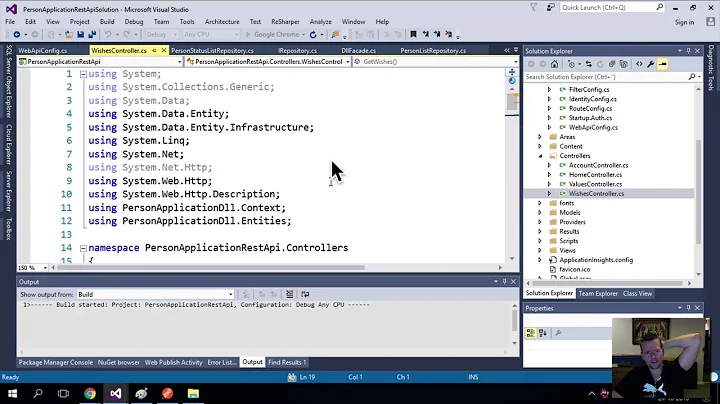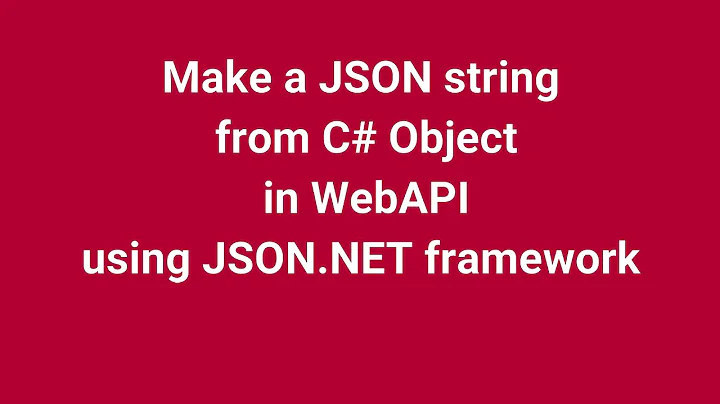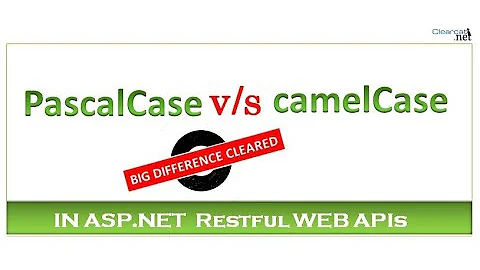Web API 2: how to return JSON with camelCased property names, on objects and their sub-objects
Solution 1
Putting it all together you get...
protected void Application_Start()
{
HttpConfiguration config = GlobalConfiguration.Configuration;
config.Formatters.JsonFormatter.SerializerSettings.ContractResolver = new CamelCasePropertyNamesContractResolver();
config.Formatters.JsonFormatter.UseDataContractJsonSerializer = false;
}
Solution 2
This is what worked for me:
internal static class ViewHelpers
{
public static JsonSerializerSettings CamelCase
{
get
{
return new JsonSerializerSettings {
ContractResolver = new CamelCasePropertyNamesContractResolver()
};
}
}
}
And then:
[HttpGet]
[Route("api/campaign/list")]
public IHttpActionResult ListExistingCampaigns()
{
var domainResults = _campaignService.ListExistingCampaigns();
return Json(domainResults, ViewHelpers.CamelCase);
}
The class CamelCasePropertyNamesContractResolver comes from Newtonsoft.Json.dll in Json.NET library.
Solution 3
It turns out that
return Json(result);
was the culprit, causing the serialization process to ignore the camelcase setting. And that
return Request.CreateResponse(HttpStatusCode.OK, result, Request.GetConfiguration());
was the droid I was looking for.
Also
json.UseDataContractJsonSerializer = true;
Was putting a spanner in the works and turned out to be NOT the droid I was looking for.
Solution 4
All the above answers didn't work for me with Owin Hosting and Ninject. Here's what worked for me:
public partial class Startup
{
public void Configuration(IAppBuilder app)
{
// Get the ninject kernel from our IoC.
var kernel = IoC.GetKernel();
var config = new HttpConfiguration();
// More config settings and OWIN middleware goes here.
// Configure camel case json results.
ConfigureCamelCase(config);
// Use ninject middleware.
app.UseNinjectMiddleware(() => kernel);
// Use ninject web api.
app.UseNinjectWebApi(config);
}
/// <summary>
/// Configure all JSON responses to have camel case property names.
/// </summary>
private void ConfigureCamelCase(HttpConfiguration config)
{
var jsonFormatter = config.Formatters.JsonFormatter;
// This next line is not required for it to work, but here for completeness - ignore data contracts.
jsonFormatter.UseDataContractJsonSerializer = false;
var settings = jsonFormatter.SerializerSettings;
#if DEBUG
// Pretty json for developers.
settings.Formatting = Formatting.Indented;
#else
settings.Formatting = Formatting.None;
#endif
settings.ContractResolver = new CamelCasePropertyNamesContractResolver();
}
}
The key difference is: new HttpConfiguration() rather than GlobalConfiguration.Configuration.
Solution 5
Code of WebApiConfig:
public static class WebApiConfig
{
public static void Register(HttpConfiguration config)
{
// Web API configuration and services
// Web API routes
config.MapHttpAttributeRoutes();
config.Routes.MapHttpRoute(
name: "DefaultApi",
routeTemplate: "api/{controller}/{id}",
defaults: new { id = RouteParameter.Optional }
);
//This line sets json serializer's ContractResolver to CamelCasePropertyNamesContractResolver,
// so API will return json using camel case
config.Formatters.JsonFormatter.SerializerSettings.ContractResolver = new CamelCasePropertyNamesContractResolver();
}
}
Make sure your API Action Method returns data in following way and you have installed latest version of Json.Net/Newtonsoft.Json Installed:
[HttpGet]
public HttpResponseMessage List()
{
try
{
var result = /*write code to fetch your result - type can be anything*/;
return Request.CreateResponse(HttpStatusCode.OK, result);
}
catch (Exception ex)
{
return Request.CreateResponse(HttpStatusCode.InternalServerError, ex.Message);
}
}
Related videos on Youtube
Tom
Updated on July 08, 2022Comments
-
Tom almost 2 years
UPDATE
Thanks for all the answers. I am on a new project and it looks like I've finally got to the bottom of this: It looks like the following code was in fact to blame:
public static HttpResponseMessage GetHttpSuccessResponse(object response, HttpStatusCode code = HttpStatusCode.OK) { return new HttpResponseMessage() { StatusCode = code, Content = response != null ? new JsonContent(response) : null }; }elsewhere...
public JsonContent(object obj) { var encoded = JsonConvert.SerializeObject(obj, Newtonsoft.Json.Formatting.None, new JsonSerializerSettings { NullValueHandling = NullValueHandling.Ignore } ); _value = JObject.Parse(encoded); Headers.ContentType = new MediaTypeHeaderValue("application/json"); }I had overlooked the innocuous looking JsonContent assuming it was WebAPI but no.
This is used everywhere... Can I just be the first to say, wtf? Or perhaps that should be "Why are they doing this?"
original question follows
One would have thought this would be a simple config setting, but it's eluded me for too long now.
I have looked at various solutions and answers:
https://gist.github.com/rdingwall/2012642
doesn't seem to apply to latest WebAPI version...
The following doesn't seem to work - property names are still PascalCased.
var json = GlobalConfiguration.Configuration.Formatters.JsonFormatter; json.UseDataContractJsonSerializer = true; json.SerializerSettings.NullValueHandling = Newtonsoft.Json.NullValueHandling.Ignore; json.SerializerSettings.ContractResolver = new CamelCasePropertyNamesContractResolver();Mayank's answer here: CamelCase JSON WebAPI Sub-Objects (Nested objects, child objects) seemed like an unsatisfactory but workable answer until I realised these attributes would have to be added to generated code as we are using linq2sql...
Any way to do this automatically? This 'nasty' has plagued me for a long time now.
-
Aron about 9 years
-
Aron about 9 yearsAlso there is a reason why Linq2SQL produces partial classes. Also...Linq2SQL WTF?!
-
Tom about 9 yearsThanks but this link is for MVC, it's Web API 2 I'm using, and I'm not sure if there's a way to set the content-type like this, and return a string, but if there is it doesn't seem like quite the right solution.. Thanks for the tip about partial classes too, but is it possible to add an attribute to a property defined in the other part of the partial?
-
Tom about 9 yearsAlso yes, linq2sql wtf... not my decision :)
-
Aron about 9 yearsthe result is the same, the only difference is where you inject the
JsonSerializer. stackoverflow.com/questions/13274625/… -
Aron about 9 yearsyes it is possible, but not in C#. You'd probably want to achieve it using some sort of compile time AOP like PostSharp or Fody.
-
-
Tom about 9 yearsDefinitely the way to turn it on, but my problem was that this setting was being ignored (see my answer)
-
Aron about 9 years@Tom erm...Tom did you know what
json.UseDataContractJsonSerializer = true;does? It tells WebAPI not to useJson.Netfor serialization. >_< -
Tom about 9 yearsYes, I do now. However, there was also an additional problem. I verified this. See my answer. Also see stackoverflow.com/questions/28552567/…
-
Tom about 9 yearsThis is actually the wrong answer. See my update in the question.
-
Tom about 9 yearsIn fact, on closer inspection it turns out that I was mistaken in my earlier conclusion. See my update.
-
Julian Melville over 8 yearsFor self-hosting via OWIN, this is perfect. Thanks!
-
droidbot about 8 yearsThis approach is very useful when one wants to have the camelCasing only for some APIs, not for all the APIs in the application. (Y)
-
Alastair about 7 yearsIf you are using Owin, this solution works perfectly, but only after you tear all your hair out!
-
DeeKayy90 over 6 yearsI actually found this to be the case. When returning
Json(result), I was seeing everything in PascalCase, but when I returnedContent(StatusCode, result)it worked as expected.












